Zuo-Guang. Ye Advanced Dielectric Piezoelectric and Ferroelectric Materials: Synthesis, Characterisation and Applications
Подождите немного. Документ загружается.

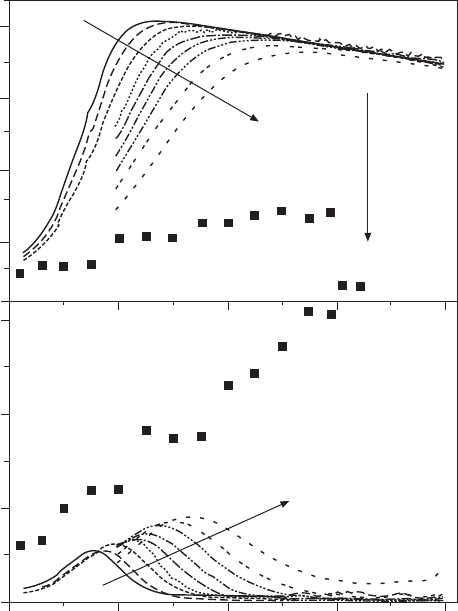
Handbook of dielectric, piezoelectric and ferroelectric materials520
losses. The dielectric spectra obtained in a broad spectral range show that the
best MW properties, i.e. the lowest dielectric losses, were observed in the
Ca-substituted monoclinic BZN (ε∼75, Qf ≥ 5000 GHz), apparently due to
the reduced extrinsic contributions to dielectric losses.
17.4.4 Dielectric relaxation
A low-temperature dielectric anomaly in bismuth-based cubic pyrochlores
was first observed by Cai et al. (1994) and then studied by Cann et al. (1996)
and Nino et al. (2001a) who stated that the anomaly appears similar to the
dispersion that occurs near the freezing temperature of dipolar glass systems.
A wide-range dielectric response of the cubic pyrochlore Bi
1.5
ZnNb
1.5
O
7
and
ε′
160
140
120
100
80
30
20
10
0
ε″
0 100 200 300 400
Temperature (K)
(b)
(a)
f
f
1 kHz
10 kHz
100 kHz
1 MHz
3 MHz
10 MHz
30 MHz
100 MHz
300 MHz
1 GHz
300 GHz
17.6
Temperature dependence of the real (a) and imaginary (b) part
of dielectric permittivity at selected frequencies between 1kHz and
300GHz (full squares) (Kamba
et al
., 2002).
WPNL2204
Bismuth-based pyrochlore dielectric ceramics 521
zirconolite-like pyrochlore phase Bi
2
Zn
2/3
Nb
4/3
O
7
was studied in detail by
Kamba et al. (2002) and Nino et al., 2002) (see Fig. 17.6) The results
showed that no dielectric relaxation exists in Bi
2
Zn
2/3
Nb
4/3
O
7
below the
phonon frequencies because of the ordered crystal structure, while in the
case of Bi
1.5
ZnNb
1.5
O
7
a strong relaxation arises as a consequence of the
local hopping of atoms in the A and O′ positions of the pyrochlore structure
among several local potential minima. The broad distribution of relaxation
frequencies is a consequence of distribution of the barrier heights for the
hopping of disordered atoms, due to random fields from inhomogeneous
distribution of Zn
2+
atoms and vacancies on the Bi
3+
sites.
Cubic pyrochlore (Bi
1.5
Zn
0.5
)(Zn
0.5–x/3
Ti
x
Nb
1.5–2x/3
)O
7
ceramics with 0 ≤ x
≤ 1.5 were synthesized and investigated between 100 Hz and 100 THz by
means of broad-band dielectric spectroscopy, time-domain THz transmission
spectroscopy, Fourier transform infrared reflectivity spectroscopy and Raman
scattering (Du et al., 2002b; H Wang et al., 2006a). Substitution of Ti atoms
on the B-sites, i.e. increasing x, results in an increase of the microwave
permittivity from 150 to 200, of the relaxation frequency and also of the
microwave quality factor Q. Low-temperature Raman scattering experiments
did not reveal any phase transition in the samples under study. As for the
origin of the relaxation, it might stem from the hopping of dynamically
disordered A and O′ atoms among the possible sites. Disorder of these atoms
is only slightly influenced by Ti substitution in the B sites while the activation
energy for the hopping of disordered atoms decreases and MW permittivity
increases with Ti substitution due to enhanced polar phonon and dielectric
relaxation contributions (H Wang et al., 2006a). It is clear that the
inhomogeneous distribution of Zn atoms and vacancies on the Bi sites gives
rise to additional random fields. This could yield multi-well potentials for
the Zn and Bi cations on the A sites that have a wide distribution of potential
heights and therefore of transition rates for anharmonic hopping.
An atomic disorder on A sites together with the associated structural
relaxation of O′A
2
substructure was first proposed by Levin et al. (2002a)
and recently it has been confirmed by direct TEM observations (Withers et
al., 2004; Y Liu et al., 2007). It was also shown that such structural disorder
is not affected by the B site substitution of the Ti or Sn ions for Nb ions (Y
Liu et al., 2007). The broad distribution of relaxation frequencies is caused
by a distribution of activation energies for the hopping of A and O′ atoms
from zero to about E
a
= 0.2 eV in pure (Bi
1.5
Zn
0.5
)(Zn
0.5
Nb
1.5
)O
7
(Kamba et
al., 2002). In the case of Ti containing samples, a similar broad relaxation
was also observed and the upper limit for activation energies E
a
decreases
with Ti concentration.
Similar dielectric relaxation was observed and studied in the Bi
2
O
3
–ZnO–
Ta
2
O
5
system as well (Youn et al., 2002; A Chen et al., 2003; Shen et al.,
2005).
WPNL2204

Handbook of dielectric, piezoelectric and ferroelectric materials522
Table 17.9
Dielectric data of (Bi
1.92
M
0.08
)(Zn
0.64
Nb
1.36
)O
7
(M = Zn, Ca, Cd, Sr, Ba) ceramics in MHz, MW and THz range (H Wang
et al.
,
2006b)
M
= ST (°C) Radius of Polariza- ρ (Ω cm) Density ε
r
(MHz) ε
r
(GHz) ε
r
(THz) tanδ
Qf
(GHz)
Qf
(THz) α
ε
M ions (Å) bilities of (g/cm
3
) (MHz) (ppm/°C)
M ions
Zn 1000 0.75 2.09 ≥10
12
7.516 82 75 77 0.0014 1755 3090 248
Cd 980 1.07 3.40 ≥10
12
7.590 88 76 76 0.0044 660 3130 336
Ca 960 1.12 3.05 ≥10
12
7.440 80 76 76 0.0005 3989 3050 214
Sr 940 1.25 4.25 ≥10
12
7.536 93 76 76 0.0013 1100 3310 272
Ba 1000 1.42 6.40 ≥10
12
7.631 99 90 83 0.013 20 3660 819
WPNL2204
Bismuth-based pyrochlore dielectric ceramics 523
17.4.5 Dielectric tunability in BZN thin films
High-permittivity thin films are being investigated for high frequency (HF)
and microwave applications in integrated high-density storage devices,
decoupling capacitors and electric-field tunable devices. For these applications,
both high permittivity and low dielectric loss are needed. (Ba,Sr)TiO
3
thin
films, currently a main candidate for these applications, have some
shortcomings such as over-high permittivity to make the impedance matching
difficult and higher dielectric loss. The family of BZN thin films having
medium permittivity (170), low loss (0.0005) and a modest temperature
coefficient (–470~+200 ppm/°C) is a good candidate for integration applications
(Ren et al., 2001; Lu et al., 2003a). Especially the observed tunability of the
BZN cubic pyrochlore thin film caused great interests and attentions for
tunable device applications (Ren et al., 2001). The BZN thin films were thus
extensively studied and successfully prepared by several chemical or physical
routes, such as radio frequency (RF) magnetron sputtering (Lu et al., 2003b,
2004; Ha et al., 2005; Hong et al., 2002), metal organic decomposition
(MOD) (Ren et al., 2001; Thayer et al., 2003; JG Chen et al., 2005; JY Kim
et al., 2005), metal organic chemical vapor deposition (MOCVD)
(Okaura et
al., 2005) and pulsed laser deposition (PLD) (Cheng et al., 2000, 2004; Jiang
et al., 2006; Ko et al., 2005). The tunability was observed in cubic
Bi
1.5
ZnNb
1.5
O
7
thin film but not in monoclinic zirconolite-like Bi
2
(Zn
1/3
Nb
2/
3
)
2
O
7
thin film. The tunability of Bi
1.5
ZnNb
1.5
O
7
thin film made by RF
magnetron sputtering was reported to be the highest, up to 55% (see Fig.
17.7a), with low dielectric loss of 0.0005 on sapphire substrates at 1 MHz
under a bias of 2.4 MV/cm (Lu, 2003a). It is interesting that the high tunability
of the Bi
1.5
ZnNb
1.5
O
7
thin film is still observed at 1 GHz as shown in Fig.
17.7(b) and seems frequency independent compared with that at 1 MHz.
Attempts to lower the conductor loss from the bottom electrodes of BZN
thin film were made on using Au bottom electrodes on sapphire substrates
(see Fig. 17.8a), which achieved a low-loss BZN metal–insulator–metal
capacitors with tunabilities of ~50% and the dielectric loss tangents of 0.0005
(see Fig. 17.8b) at 1 MHz (Lu et al., 2006). The electric field tunability of the
permittivity was weakly temperature dependent and increased with decreasing
temperature up to the onset of dielectric relaxation (Tagantsev et al., 2005).
At temperatures below the onset of the dielectric relaxation (~150 K at 1 MHz),
larger electric fields were required to achieve the highest tunabilities. However,
the weak temperature dependence at temperatures after the onset of dielectric
relaxation of BZN thin films gives them a practical advantage over ferroelectric
materials in making the temperature-stable tunable devices. In a first
approximation, at temperatures above the dielectric relaxation, the temperature
dependence of the BZN film tunability can be described by a simple model
of hopping dipoles under the influence of random fields. This is consistent
with the chemical and displacive randomness of the BZN structure that
WPNL2204
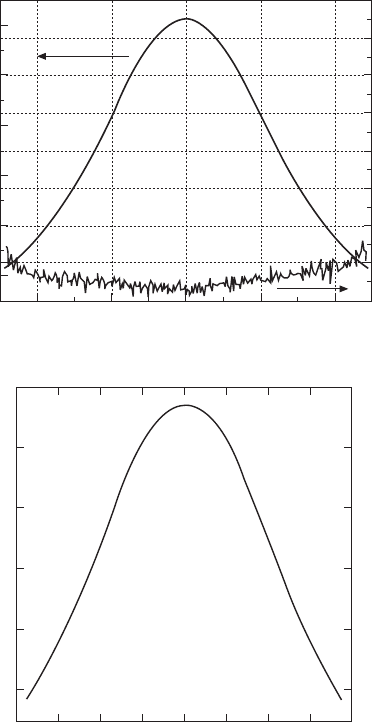
Handbook of dielectric, piezoelectric and ferroelectric materials524
controls the dielectric behaviour (Kamba et al., 2002; Levin et al., 2002a;
Withers et al., 2004). It is deduced (H Wang et al., 2006b) and evidenced (JY
Kim et al., 2005) that the Ti-doped BZN cubic pyrochlore thin films with
decreased activation energies E
a
for hopping have higher tunabilities than
those of pure BZN thin films.
To combine the advantages of both the BST thin film (higher tunability)
and the BZN thin film (low dielectric loss), composite BST–BZN thin film
and hetero-layered BST/BZN were proposed and prepared. The BST/BZN
composite thin films were found to have tunability around 6.2% under the
1 GHz
–2 –1.5 –1 –0.5 0 0.5 1 15 2
Bias field (MV/cm)
(b)
Capacitance density (fF/µm
2
)
11
10
9
8
7
6
17.7
Bias dependence of permittivity of BZN thin film at 1 MHz (a) (Lu
et al.
, 2003a) and at 1 GHz (b) (Tagantsev
et al.
, 2005).
–2 –1 0 1 2
Field (MV/cm)
(a)
Permittivity
180
160
140
120
100
80
8
7
6
5
4
3
2
1
0
tan δ(× 10
–3
)
WPNL2204
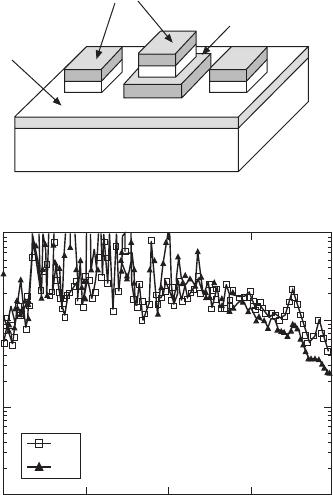
Bismuth-based pyrochlore dielectric ceramics 525
bias of 8.1 kV/cm (L Yan et al., 2004) and an abnormal C–V characteristic
(Tian et al., 2006), while the heterolayered BST/BZN thin film was found to
have a higher tunability up to 25% and very low loss of 0.0025 at 1 MHz,
which leads the way for further developing new tunable dielectric thin films
by controlling the layer ratio of BST and BZN layers (Fu et al., 2006).
To make the integration with polymeric substrates possible, further lowering
the processing temperature is needed. The crystallization temperature of
Bi
1.5
Zn
0.5
Nb
1.5
O
6.5
(BZN) films was reduced by combining the conventional
heating and irradiation with a pulsed KrF excimer laser to MOD-derived
BZN thin films at substrate temperatures ≤ 400 °C (JG Chen et al., 2005).
17.5 Potential RF and microwave applications
The high dielectric constants, relatively low dielectric losses (high-quality
factor), controllable TCC with the low sintering temperatures (below 1000 °C)
Sapphire
(a)
Au bottom
electrode
Au/Pt top contact
BZN film
17.8
Schematic of the parallel plate BZN capacitor devices (a) and the
Q
factors of an ~200 nm thick BZN thin film on 200nm thick Au
bottom electrode and 100 nm thick Pt bottom electrode (b) (Lu
et al
.,
2006).
Au
Pt
10
4
10
5
10
6
10
7
10
8
Frequency (Hz)
10
4
10
3
10
2
10
1
Q
(b)
WPNL2204
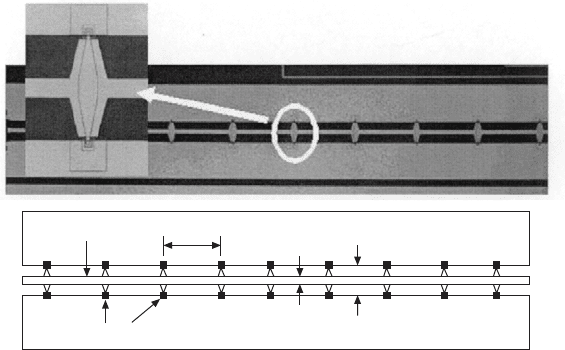
Handbook of dielectric, piezoelectric and ferroelectric materials526
and high electrical tunability make the BZN system a very appealing candidate
for applications in low-fire multilayer devices and tunable devices from
high-frequency to microwave range.
17.5.1 Voltage tunable devices
As mentioned above, BZN cubic pyrochlores have high dielectric tunability
(~55%) and very low dielectric loss tangent (<0.0005) which make them the
new candidates for voltage-tunable devices, such as tunable filter, tunable
antenna and phase shifter, etc. Lu et al. (2006) reported a low-loss tunable
capacitors fabricated directly on gold bottom electrodes by using BZN cubic
pyrochlore thin film (J Park et al., 2005). The total device loss was reduced
compared with that with Pt bottom electrodes. Figure 17.8 (a) shows the
schematic of the parallel plate capacitor devices and the Q factors of the Au/
BZN capacitors. This result is of interest for other microwave-tunable devices
applications which require a low thermal budget and high-quality, high-
permittivity dielectric films.
J Park et al. (2006) reported a monoclinic Ku-band phase shifter employing
voltage tunable Bi
1.5
ZnNb
1.5
O
7
thin film parallel plate capacitors. The BZN
films were deposited by RF magnetron sputtering on single-crystal sapphire
substrates. By using a nine-section distributed coplanar waveguide loaded-
line phase-shifter structure (see Fig. 17.9), a phase shifter with a differential
phase shift of 175° and a maximum insertion loss of 3.5 dB at 15 GHz was
achieved.
Very recently Lee et al. (2006) reported a very high-tunable inter-digital
capacitor (IDC) using BZN pyrochlore thin film dielectrics for microwave
RF
OUT
RF
IN
CPW signal
BZN capacitors
L
CPW ground
CPW ground
w
w
+ 2
g
17.9
Photograph and schematic of the BZN phase shifter (
L
: 340 µm,
w
: 30µm,
g
: 70 µm) (J Park
et al
., 2006).
WPNL2204
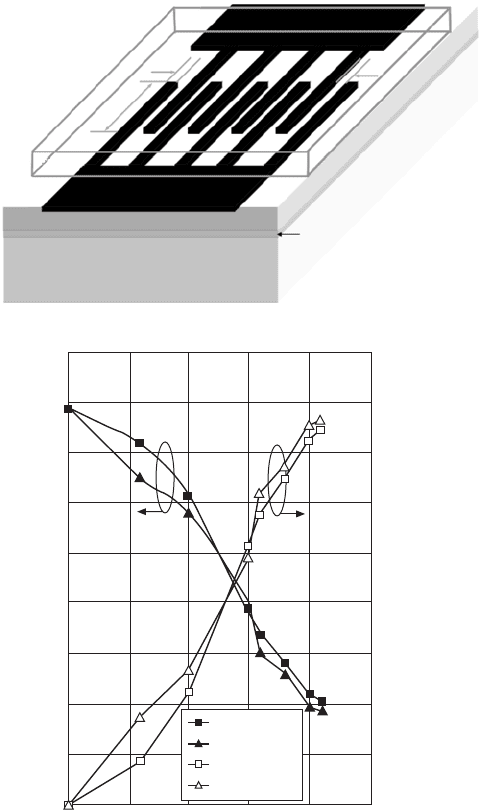
Bismuth-based pyrochlore dielectric ceramics 527
applications. They used a structure with the electrodes fully embedded into
tunable BZN dielectrics as show in Figure 17.10 to increase the tunability of
the IDC and reduce dc bias voltage. The results show that at 20 V dc the IDC
yields a tunability up to 72 and 75% at 2.4 and 5.8 GHz respectively. That is
the highest tunability of BZN dielectrics reported so far.
(a)
Si-substrate
SiO
2
BZN 1
IDC(M1: Pt)
BZN 2
l
L
S
17.10
Inter-digital capacitor with electrodes fully embedded into BZN
dielectrics (
L
=1.5 µm,
S
= µm,
l
= 47 µm) (a) and its measured
effective capacitance and tunability (b) (Lee
et al
., 2006).
2.4GHz–
C
eff
5.8GHz–
C
eff
2.4GHz–
C
t
5.8GHz–
C
t
0 5 10 15 20 25
DC bias (V)
(b)
C
eff
(F × 10
–12
)
2.3
2.0
1.8
1.5
1.3
1.0
7.5
5.0
2.5
0.0
90
80
70
60
50
40
30
20
10
0
Tunability (%)
WPNL2204
Handbook of dielectric, piezoelectric and ferroelectric materials528
17.5.2 Antenna applications
Among various possible internal antennas in wireless hand-held devices, the
ceramic antenna is a good candidate because it has the advantages of compact
size and easier fabrication. Ceramic antennas can be mounted on the circuit
board by Surface Mount Technology (SMT) which can reduce the cost of the
installation. Bismuth-based ceramics are suited for the antenna application
due to their relatively high dielectric constant and low dielectric loss in RF
and microwave range. A prototype resonator antenna was simulated and
fabricated (Z Peng et al., 2004). Then a two-element antenna array has been
designed and fabricated as shown in Fig. 17.11. It shows the simulated and
measured S
11
parameters of the model. The simulated resonant frequency is
3.59 GHz and the simulated bandwidth is 50 MHz (based on S
11
<–10 dB).
The measured result shows that the element antenna resonates at 3.08 GHz
and has a bandwidth of 33MHz (Zhou et al., 2007).
17.5.3 LTCC applications
A low-temperature co-fired ceramic (LTCC) device is one of the most rapidly
developed integral passive devices which provides a solution to the integration
of passive components, such as capacitor, resistor, inductor, resonator and
filter, etc. into a multilayered ceramic module by interconnecting each
component in layers. Recently most of the commercial LTCC systems have
a relative dielectric constant (K) between 5 and 10 with only a few between
10 and 20. However, mid-K or high-K LTCC dielectrics with a dielectric
constant >20 are necessary for miniaturized LC filters and for increasing the
capacitive volumetric efficiency of embedded components. Bismuth-based
pyrochlore dielectrics BZS (K = 35), BZT (K = 60) and BZN (K = 75–100)
with dielectric constants in series are highly suitable for capacitor integration
in LTCC. The BZN dielectrics also show the advantages of their compatibility
with Ag electrodes without chemical reaction for LTCC applications (Nino
et al., 2001b; Su et al., 2003). A multilayered prototype resonator and filter
were fabricated (Randall et al., 2003). A high-K bismuth-based pyrochlore
was successfully embedded in Dupont 951 LTCC as shown in Fig. 17.12,
which reveals that the shrinkage rates of all the layers were well matched
and no chemical reaction took place between the LTCC dielectrics and Ag
electrodes.
17.5.4 EBG structure and new devices
Novel two-dimensional electromagnetic bandgap structures (2D EBGs)
(Fig. 17.13) were fabricated by the moulding/demoulding technology based
on the simulations, with high permittivity BZN dielectrics. The impacts of
WPNL2204
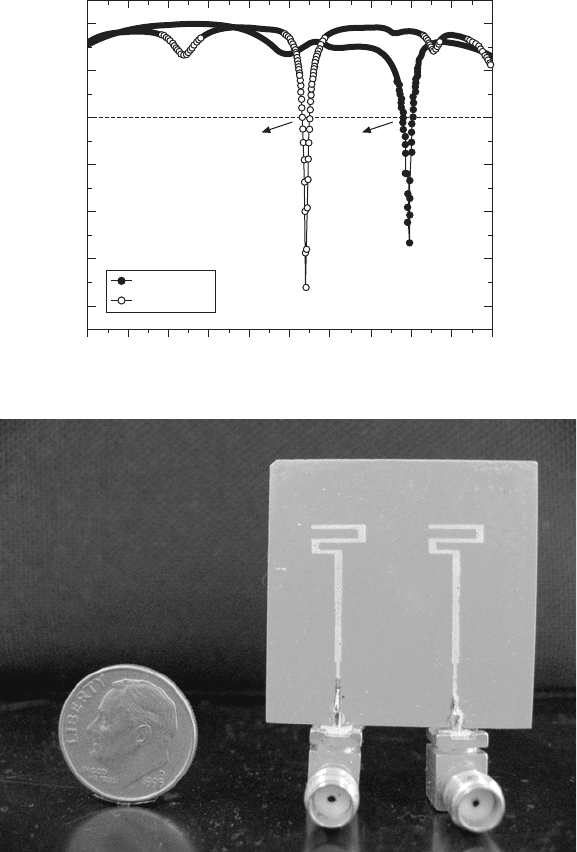
Bismuth-based pyrochlore dielectric ceramics 529
Simulated
Measured
2.0 2.2 2.4 2.6 2.8 3.0 3.2 3.4 3.6 3.8 4.0
Frequency (GHz)
(a)
33 MHz
50 MHz
S
11
(dB)
0
–5
–10
–15
–20
–25
–30
(b)
17.11
Measured and simulated resonate frequencies (a) of a two-
element antenna by using BZN dielectric as substrates (b).
high permittivity on the 2D EBGs’ properties showed very interesting multi-
bandgap phenomenon (Shi et al., 2007),
which is different from that of the
photonic crystals by using low permittivity dielectrics. The experiments (see
Fig. 17.13) showed that the wider electromagnetic band gaps are found in
the frequency ranges from 5.6 to 10.6GHz, and 12.6 to 16.6 GHz. The first
WPNL2204
